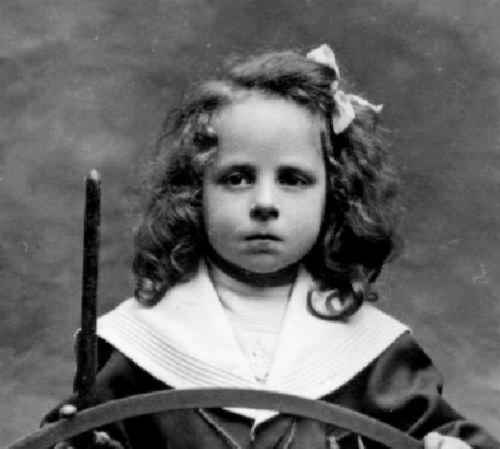
Figure 1.--This Parisian boy wears a hairbow with uncurled hair. Rinlets were less comman in France than America. HBC notes the portrait at about 1890. Click on the image to see the boy and his hoop. |

|
Hair bows appar to have been most common on the Continent. I am aware of relatively few photographs in Britain and the United States of boys weraing hairbows. The practice on the continent, especially France seems much more widespread. Note that in the wealth of
photographs of American and British boys in Fauntleroy suits and Fauntleroy dresses, even the ones still in
curls, I know of none with the addes indignity of girlish hair ribbons.
Clothing and hair styles in Belgiun, especilly the Waloon or French speaking areas, were quite similar to those in France. I'm less sure about Flanders where Dutch or German influences were also important. Despite the cultural divide, Vrench fashions appear to have been more important in Flanders than either the Netherlands or Germany.
We have not noted any portraits of Canadian boys wearing hairbows. This may be a result of the limited number of images available to us. We have also not noted any hairbow images oof boys in the Canadian Notman collection, although we have only seen part of it. A HBC reader writes, "Yes, it is strange that none of the boys that I have seen in the Notman Collection have hair bows. You would think that since Quebec is a French speaking province, they would follow the French fashion. Also the photographs online have a lot of gaps in coverage. A lot of the photos are from 1880, 1885, and 1891 with in intervening years
missing. It would also be interesting to know if romper and choupettes hair styles were popular in the provance in the forties and fifties. I did find one child in a dress and rinlets with a hair ribbon that I think is a boy, but I can't be sure."
I have so far found no information on England. While not nearly as prevalent as in France, the photographic record does show that some English boys did also wear hair bows. I have not yet been able to assess the prevalence and characteristics of this custom in England as I currently have access to relatively few images. I believe this is in part because as an Amerivan I primarily have access to American images. I do not know of any English researcher to address this topic yet.
Most of the available images of boys wearing hair bows suggest the practice occurred primarily on the Continent, especially in France. French boys did not wear ringlet curls to the same extent that American boys did, but their mothers more commonly added bows to their sons uncurled hair. The fashion appears to have been used to contrl a boys' hair. I do not know, however, how common it was for a boy to wear them. He may not have normally worn then during the day and they may have just been added for specoal ocassions.
We have very limited informaion on Germany. The practice may have been less common in Germany than elsewhere, but I believe that the fashion did exist. We have seen a few German boys wearing hairbows. The fashion may have been more common in Bavaria where French fashions seem more influential tham elsewhere in Germany. We have also seen a few Berlin boys wearing hair bows. Other than the few photographs, we have no information from published sources about German boys wearing hairbows. We have seen them with both ringlet curls and straiht hair as well as on breeched and unbreeched boys.
I have little information on Italy so far. It appears that Italian mothers were particularly enamored of leaving their sons in long hair. Some mothers curled the long hair of their boys, but curling may not have been as popular as in the United States. Unfortunately, HBC has virtually no information on how common this fashion was in Italy.
|
Hair bows for boys were not just a French fashion. Dag Hammarskjold, the future United Nations Secretary General, was dressed in dressed as a little boy in Sweden. Even after he started wearing Faitleroy and other fancy suits he wore long hair with elaborate sausage curls and hair bows. Note the difference with the French boys above who wear long, but uncurled hair. HBC is, however, not at all sure about how common this fashion was in Sweden.
Available inf ormation suggests that American mothers were less likely to use hair bows on their boys with long hair. This does not mean, however, that American and British boys never wore hair bows. As noted above there were some mothers who thought the
style was attractive. In fact, there is a surprising number of 19th Century photographic images showing that quite a number of American mothers were enamored with this fashion. While the overall percentage of
American boys with long hair wearing hair bows is small, it is not inconsequential.
Navigate related Boys' Historical Clothing Web Site pages:
[Return to the Main boy' hairbow page]
[Hair styles]
[Collar bows]
[Dresses]
[Kilt suits]
[Kilts]
[Fauntleroy suits]
[Fauntleroy dresses]
[Sailor dresses]
[Pinafores]
[Smocks]
Navigate the Boys' Historical Clothing Web Site:
[Introduction]
[Activities]
[Biographies]
[Chronology]
[Clothing styles]
[Countries]
[Bibliographies]
[Contributions]
[Essays]
[FAQs]
[Glossaries]
[Images]
[Links]
[Registration]
[Tools]
[Boys' Clothing Home]
